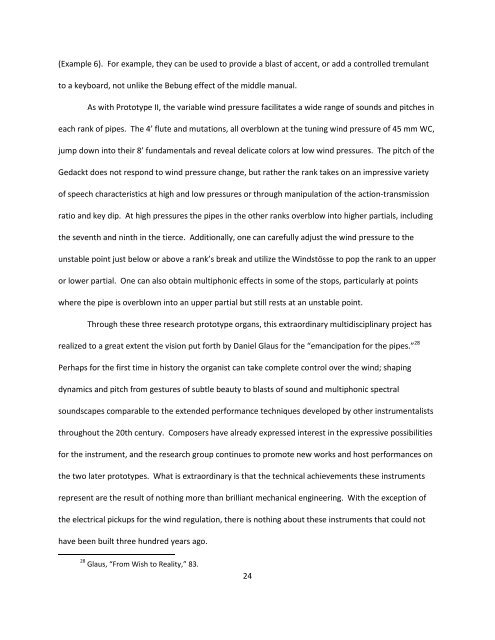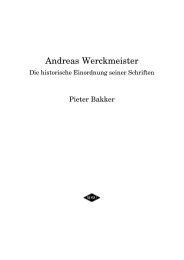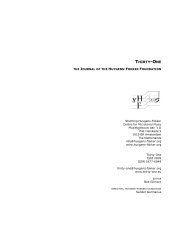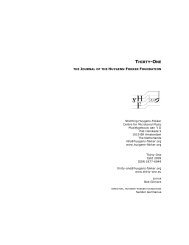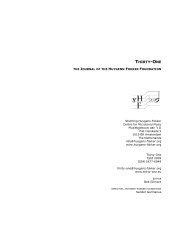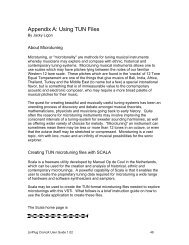Recent Organ Design Innovations and the 21st-century - Stichting ...
Recent Organ Design Innovations and the 21st-century - Stichting ...
Recent Organ Design Innovations and the 21st-century - Stichting ...
You also want an ePaper? Increase the reach of your titles
YUMPU automatically turns print PDFs into web optimized ePapers that Google loves.
(Example 6). For example, <strong>the</strong>y can be used to provide a blast of accent, or add a controlled tremulant<br />
to a keyboard, not unlike <strong>the</strong> Bebung effect of <strong>the</strong> middle manual.<br />
As with Prototype II, <strong>the</strong> variable wind pressure facilitates a wide range of sounds <strong>and</strong> pitches in<br />
each rank of pipes. The 4’ flute <strong>and</strong> mutations, all overblown at <strong>the</strong> tuning wind pressure of 45 mm WC,<br />
jump down into <strong>the</strong>ir 8’ fundamentals <strong>and</strong> reveal delicate colors at low wind pressures. The pitch of <strong>the</strong><br />
Gedackt does not respond to wind pressure change, but ra<strong>the</strong>r <strong>the</strong> rank takes on an impressive variety<br />
of speech characteristics at high <strong>and</strong> low pressures or through manipulation of <strong>the</strong> action-transmission<br />
ratio <strong>and</strong> key dip. At high pressures <strong>the</strong> pipes in <strong>the</strong> o<strong>the</strong>r ranks overblow into higher partials, including<br />
<strong>the</strong> seventh <strong>and</strong> ninth in <strong>the</strong> tierce. Additionally, one can carefully adjust <strong>the</strong> wind pressure to <strong>the</strong><br />
unstable point just below or above a rank’s break <strong>and</strong> utilize <strong>the</strong> Windstösse to pop <strong>the</strong> rank to an upper<br />
or lower partial. One can also obtain multiphonic effects in some of <strong>the</strong> stops, particularly at points<br />
where <strong>the</strong> pipe is overblown into an upper partial but still rests at an unstable point.<br />
Through <strong>the</strong>se three research prototype organs, this extraordinary multidisciplinary project has<br />
realized to a great extent <strong>the</strong> vision put forth by Daniel Glaus for <strong>the</strong> “emancipation for <strong>the</strong> pipes.” 28<br />
Perhaps for <strong>the</strong> first time in history <strong>the</strong> organist can take complete control over <strong>the</strong> wind; shaping<br />
dynamics <strong>and</strong> pitch from gestures of subtle beauty to blasts of sound <strong>and</strong> multiphonic spectral<br />
soundscapes comparable to <strong>the</strong> extended performance techniques developed by o<strong>the</strong>r instrumentalists<br />
throughout <strong>the</strong> 20th <strong>century</strong>. Composers have already expressed interest in <strong>the</strong> expressive possibilities<br />
for <strong>the</strong> instrument, <strong>and</strong> <strong>the</strong> research group continues to promote new works <strong>and</strong> host performances on<br />
<strong>the</strong> two later prototypes. What is extraordinary is that <strong>the</strong> technical achievements <strong>the</strong>se instruments<br />
represent are <strong>the</strong> result of nothing more than brilliant mechanical engineering. With <strong>the</strong> exception of<br />
<strong>the</strong> electrical pickups for <strong>the</strong> wind regulation, <strong>the</strong>re is nothing about <strong>the</strong>se instruments that could not<br />
have been built three hundred years ago.<br />
28 Glaus, “From Wish to Reality,” 83.<br />
24


